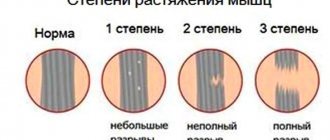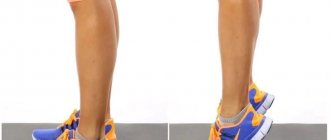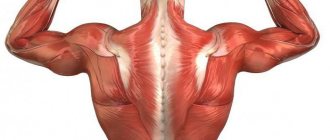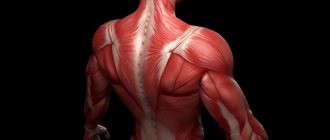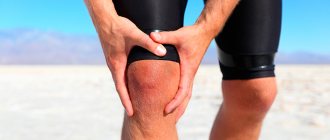Description
A biceps tendon rupture can be partial or complete.
A partial tear is a tear that does not completely break the tendon. A complete tear is a tear that divides the tendon into two parts.
In many cases, tendon rupture begins with small tears in the tendon. As the process progresses, the tendon ruptures completely, sometimes when lifting a heavy object.
The long head of the biceps is more often injured. This is because it is more susceptible to injury as it runs along the shoulder joint to its insertion point on the labrum of the glenoid. Fortunately, the biceps has two attachment points to the shoulder. The short head of the biceps is rarely torn. Thanks to the presence of a second attachment point, many people can continue to use the muscle even after tearing its long head.
When your biceps tendon tears, it can also cause damage to other parts of your shoulder, such as the rotator cuff.
The best exercises with a barbell
This is a strength workout for quick muscle gain. To maintain proper technique, the weight should be comfortable. Exercises with a barbell for biceps simultaneously develop strength and endurance in the arms.
Bend elbows with reverse grip
Holding the barbell in this position uses various muscles of the body (legs, back), so adherence to technique is especially important. When performing the exercise, completely exclude your hands from working.
Do not strive for maximum range of motion, then the muscles will contract more intensely and be pumped more effectively.
Execution order:
- Bend over the barbell and grab it with straight arms, palms facing you.
- As you exhale, bend your elbows and lift the barbell toward your shoulders.
- As you inhale, slowly extend your arms, keeping your elbows slightly bent at the bottom of the movement to protect your joints from injury.
- Repeat 10-12 times.
Straight wide grip raise
Exercise to contract the short head of the biceps. Keep your shoulders completely lowered and your back straight. For an anatomically correct position of the hands, use a curved bar. When performing this exercise for the inner biceps, it is useful to hold the raised apparatus for a few seconds and then slowly return to the starting position. This way the muscles tense as much as possible and a large amount of blood flows to them.
Technique:
- Grasp the barbell with a shoulder-width grip, palms facing away from you, with your thumb over the bar.
- Raise the projectile to your chest, hold the position for 1-2 seconds.
- Slowly lower the barbell down without fully extending your elbows to avoid damaging your joints.
- Do 10-12 reps.
Bend your arms with your elbows back
The exercise provides maximum load on the biceps. Pulling the elbows back excludes the deltoid muscles, which are involved in flexion and extension, from the movement. Heavy weights combined with minimal repetitions are needed to develop strength, but to gain muscle mass, reduce the weight and increase the number of repetitions.
- Belyashi dough - step-by-step recipes. How to prepare delicious belyashi dough quickly and easily, video
- 5 delicious recipes for salting fish at home
- What kind of fabric is viscose
The minimum weight and the maximum number of barbell lifts is a combination for working on shoulder relief.
Technique:
- Stand up straight, grab the barbell with a support grip, with your palms facing forward and your hands slightly raised up.
- As you exhale, lift the barbell, moving your elbows back. Lower your shoulders, point your elbows straight back, not to the sides.
- Slowly lower your arms while exhaling. Make sure that the bar of the bar moves up and down strictly along the torso, perpendicular to the floor.
Cause
1) Injury If you fall with great force on a straight arm or lift a heavy object, the biceps tendon may rupture.
2) Excessive stress In many cases, rupture occurs as a result of abrasion and tearing of the tendon, which slowly progresses over time.
This is a natural effect of the aging process. The condition can worsen as a result of excessive stress - repetition of the same hand movements. Overuse can cause a number of shoulder problems, such as tendonitis, impingement syndrome, or rotator cuff damage. The occurrence of any of these conditions leads to greater stress on the tendon, favoring its rupture.
Don't cheat constantly
Thinking about how to train the biceps muscles well, everyone wants to take as much weight as possible so that the muscles feel the load and work well, and many succumb to this weakness, forgetting about the technique of movement. They picked up decent weights and lifted them, puffing like a locomotive and not noticing that many muscles of the body are involved in the lifting.
If, after hanging weights or taking dumbbells, you can’t do 1-2 repetitions purely on technique, using cheating right away, definitely reduce the weight, otherwise you won’t pump up your biceps well, more so your back and deltoids.
Always use the weight at which you can perform at least 6 repetitions with perfect technique, and then 2-3 repetitions using cheating, so you can pump up your arms well with additional load at the end.
Risk factors
The risk of tendon rupture increases: • Advanced age. Older people, due to their age, load their tendons for a longer period of time than younger people. • Vigorous activity with arms raised. Excessive strain during heavy lifting is the best example, but there are many jobs that require regular lifting of heavy objects, which causes wear and tear on the tendons. • Excessive load on the shoulder joint. Sports that require repetitive overhead movements of the arms, such as swimming or tennis, can cause significant wear and tear on the tendons. • Smoking. Nicotine can affect the delivery of nutrients to tendons. • Corticosteroids. Corticosteroid use is associated with increased muscle and tendon weakness.
Don't increase your workout duration by sacrificing intensity
It's much easier to train by doing 4 biceps exercises in 60 minutes than doing 40, it's much easier and less stressful. But the goal is not simpler, but more effective, to gain weight and volume in your arms.
To do this, do not take long rests between sets, train your arms intensively and remember that the duration of the workout should be short but powerful. Otherwise, the reserves of glycogen (energy) in the body dry up quickly and if there is a deficiency, the body will begin to draw it from the muscles.
Symptoms
• Sudden sharp pain in the upper arm. • Sometimes a clearly audible cracking or crunching sound. • Contractions of the biceps muscle during intense movements of the arm. • Bruises extending from the middle of the shoulder down to the elbow. • Pain or tenderness in the shoulder and elbow area. • Weakness in the shoulder or elbow. • Difficulty turning your hand with your palm up or down. • Because the torn tendon can no longer hold the muscle under tension, a bulge above the elbow may appear in the arm, with a simultaneous concavity near the shoulder (Popeye's sign).
How to prevent post-workout pain
There are several simple ways to reduce or almost completely eliminate muscle pain after intense exercise:
– warm-up and stretching;
– massage or self-massage;
- cold and hot shower;
– consumption of large amounts of carbohydrates (sports nutrition);
– hot bath or sauna.
Let's go through each point.
During the process of growth and aging, changes occur in muscle tissue. Incorporating warm-up and stretching into a regular training schedule will ensure uniform muscle growth along the fibers and increase the level of flexibility. This will give you the ability to move in any direction with ease and provide more energy to perform various actions.
Massage in any form stimulates the outflow of blood and lymph from tight muscles, which reduces their size and micro-tears. As a result, the pain the next day will be much less.
A contrast shower for 3 to 5 minutes immediately after training allows you to narrow and dilate blood vessels, which has a beneficial effect on the outflow of blood from “clogged” muscles. Naturally, the pain should be less.
Carbohydrate foods or sports nutrition with a carbohydrate base (preferable, of course), for example, any type of gainer (high-carbohydrate or high-protein), allow you to quickly restore glycogen in the muscles, saturate the cells with energy , which will affect muscle recovery during sleep. The recovery rate in this case is the highest, and the pain the next day, as a rule, disappears completely.
Like a contrast shower, a hot bath or sauna promotes certain processes in the body that have a beneficial effect on the subsequent rest of “damaged” muscle tissue . In addition, a very warm environment relaxes and improves the quality of sleep, which cannot but affect your vacation as a whole.
What is the treatment
Glucocorticosteroids are prescribed when NSAIDs are ineffective.
Therapy for tendonitis involves long-term medication. Taking non-steroidal and anti-inflammatory drugs is aimed at eliminating inflammatory manifestations and reducing the severity of pain. If these drugs are ineffective, glucocorticosteroids are used. Treatment with surgical intervention is used very rarely and is indicated only when conservative therapy is ineffective.
The entire period of treatment, the load on the patient’s limb should be limited. In addition, it is useful to additionally take a complex of vitamins and minerals that strengthen the tissues of the musculoskeletal system. After completion of the main treatment of tendinitis and elimination of inflammatory manifestations, a course of physiotherapy with therapeutic massage and gymnastics is indicated. This will restore the functional activity of the limb.
Effective treatment for tendinitis
Effective treatment for tendinitis
First of all, it is necessary to organize complete rest for the diseased part of the body. For this purpose, if the upper extremities are affected, a bandage or splint is applied; if the lower extremities are affected, it is necessary to use crutches.
Treatment of tendonitis is effective with corticosteroid injections, which are injected directly into the lesion. Injections quickly relieve pain and help attenuate the inflammatory process. In addition to drug treatment, physical therapy is prescribed.
If conservative treatment of tendinitis does not bring the expected effect, surgery becomes necessary.
